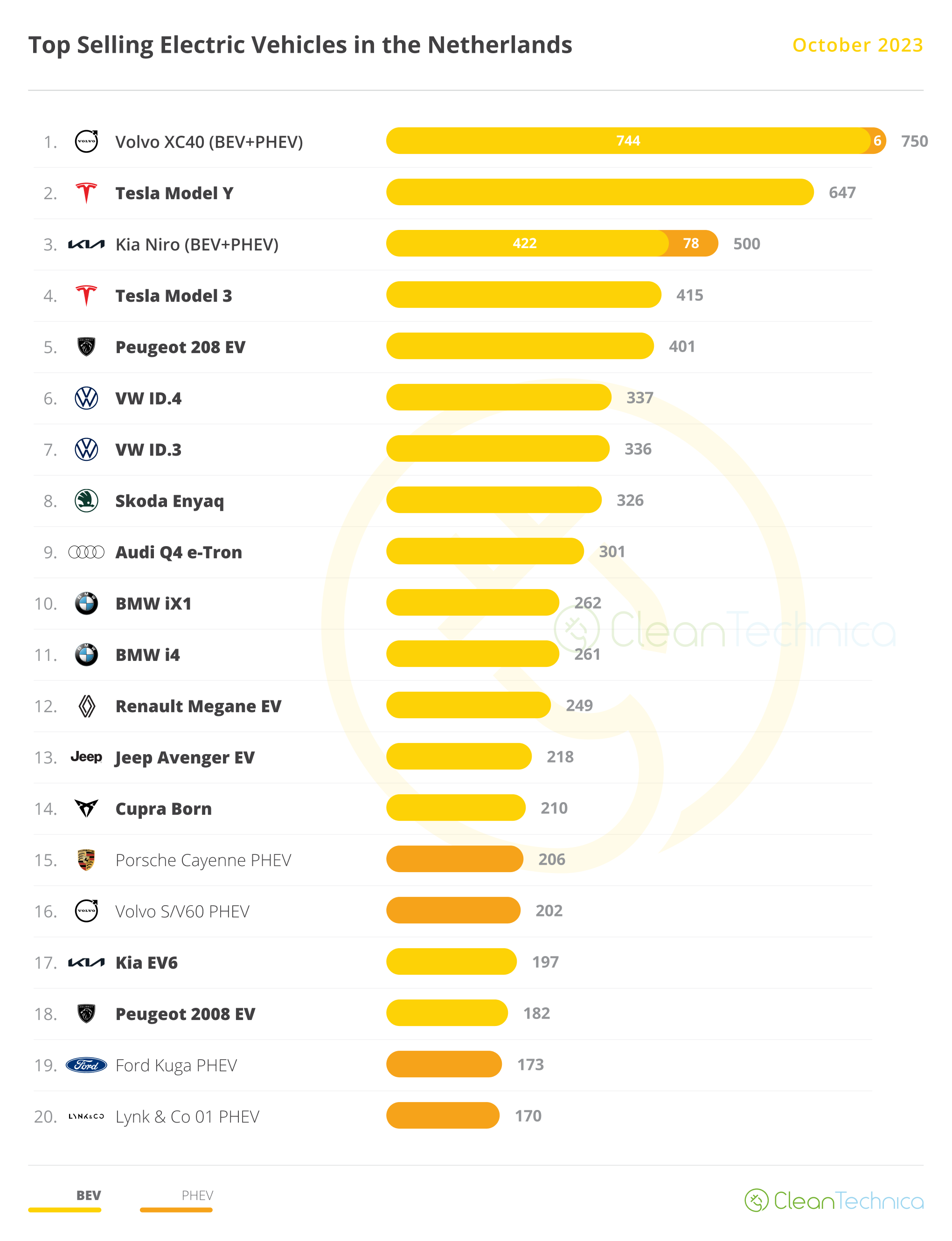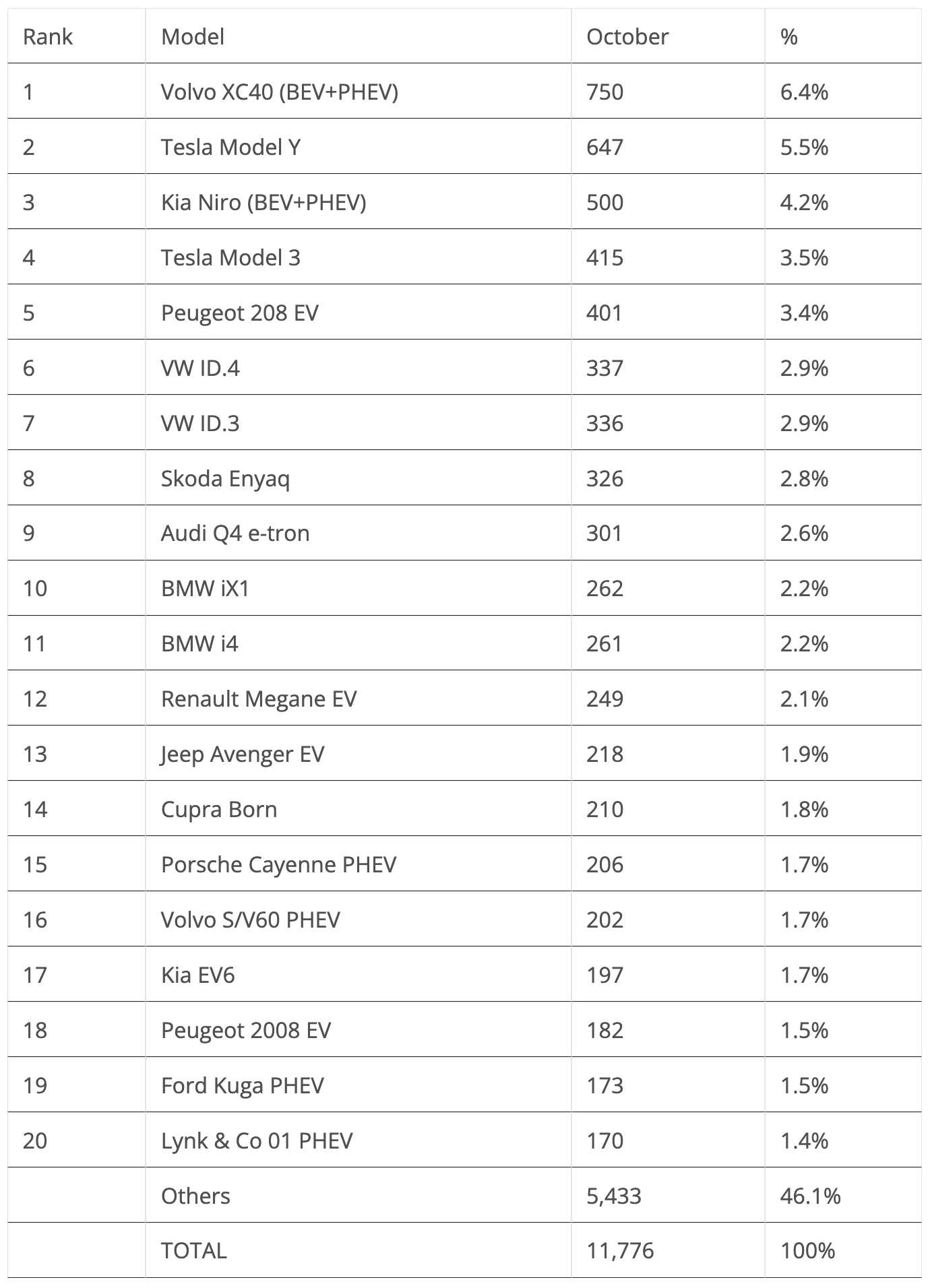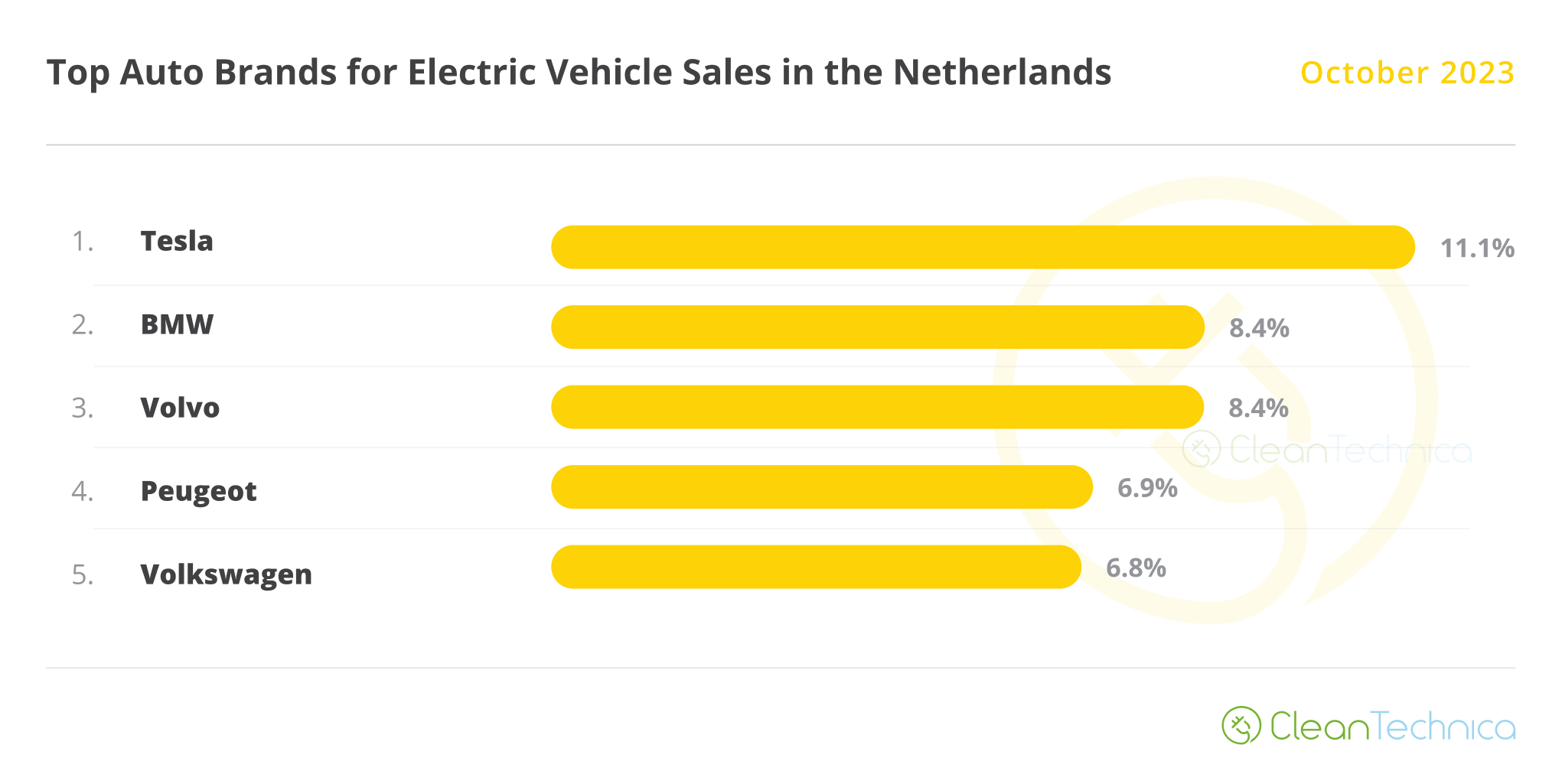Sign up for daily news updates from CleanTechnica on email. Or follow us on Google News!
In the Netherlands, 42% of new car sales were plugin car sales in October. Furthermore, 29% were full electrics!
The Dutch market saw an increase in plugin registrations to 11,776 units in October, with the plugin vehicle (PEV) market thus reaching 42% of the overall auto market last month. That kept the year-to-date (YTD) score to 43% (30% BEV). That’s mostly thanks to pure electrics (29% of new vehicle sales), which represented 69% of all plugin sales, keeping the yearly average at 69%. The EV share was also helped by the overall market, which dropped 2% YoY. There were 28,362 registrations on the overall market.
Expect the December plugin share to end above the 50% mark, and then expect the full year to end around 44%, which could mean that the Dutch market could have its EV transition finished before the end of the decade!
Looking at the overall top 5, only two models (#1 Kia Picanto & #3 VW Polo) don’t have plugin versions. Interestingly, they are either city cars (Picanto) or belong to the B-segment/subcompact category (Polo). The remaining models in the top 5 (#2 Volvo XC40, #4 Kia Niro, #5 Tesla Model Y) are either fully electric, like the Tesla Model Y and the XC40 (well, 98% of all the Swede’s registrations belong to the BEV version), or heavily electrified (60% of Niro sales belong to the BEV version).
This shows once again that while the EV transition in the upper half of the market is well advanced, the lower half still has a long way to go. Those promised €20,000-ish small EVs are badly needed….
In October, the big plugin vehicle news was that the Volvo XC40 broke the Model Y’s #1 streak (the US crossover had been the best seller in August and September), with Volvo’s SUV winning the best seller trophy after a few months without gold medals.
Still on the medals topic, the Kia Niro took the last place on the podium, keeping the refreshed and re-energized Tesla Model 3 in 4th, with 415 units — a promising result for the sedan, which might end up being the best selling model in the last quarter of the year.
In the first half of the table, the highlights come from Volkswagen Group. The German OEM placed four models on the top 10, with the #7 VW ID.3 a hair from becoming the best selling model from the German conglomerate (#6 VW ID.4, #7 VW ID.3, #8 Skoda Enyaq, #9 Audi Q4 e-tron). The bottom half of the table saw two more models shining, with the #14 Cupra Born (another MEB-platform model) ending the month with 210 registrations, a new year best, and the Porsche Cayenne PHEV(!) having its best score since December 2015(!!), 206 registrations. Note that the plugin versions represented 99% of all Cayenne registrations in Dutch lands last month. This unusually high score is the result of the first deliveries of the refreshed SUV, which, among other improvements, now has a 26 kWh battery. It’s not much, compared to the 40–50 kWh batteries in certain Chinese plugin hybrids, but still, it is three times bigger than the original Cayenne PHEV’s battery (launched back in 2015).
In 16th we have another plugin hybrid model, with the Volvo S/V60 PHEV scoring 202 registrations, the midsizer’s best result in three years. Now, some might ask: “But if PHEVs represented just 26% of plugin sales, how come we have two plugin hybrid models scoring their best results in years? Shouldn’t PHEV sales be growing in order to reflect these good results?”
Well … yes and no.
Yes, because PHEV sales have grown, by 9% YoY, and no, because while we have two models with unexpectedly good results, this year’s two best selling PHEVs in the Netherlands, the Ford Kuga PHEV and Lynk & Co 01 PHEV, had their worst results in a while. The Made in Spain crossover ended the month in #19 with just 173 registrations, its lowest score since January, while the Chinese SUV did even worse, ending the month in #20 with 170 registrations, its worst score in over a year.
A new BEV model is coming to L&K’s lineup in 2024. Let’s call it the “02” model. It is based on the SEA platform and related to the Zeekr X, Volvo EX30, etc. This new model will be a lifeline for the irreverent Chinese brand’s career in Dutch lands, as rapid electrification is turning the 01 PHEV into something of a “old hat.”
Outside the top 20, while a couple of models had good results, like the Volvo C40 reaching 158 units and the BYD Atto 3 (euro-spec BYD Yuan Plus) registering 106 units, the big news was elsewhere, in the full size segment.
This segment has long been dominated by Audi, thanks to the success of the Audi e-tron/Q8 e-tron, but this month, a few events could mark the end of the domination of the four-ringed brand. While the fact is the Porsche Cayenne PHEV outsold the Audi Q8 e-tron in October, by 206 units against 140, that shouldn’t mean much, as the sports SUV is expected to go back to two-digit monthly performances soon. This month also signaled the landing of three new full size models, which might disrupt the full size category status quo. XPeng’s G9 scored its first volume month in Dutch lands, registering 56 units. With the startup’s appealing SUV starting at just €58,000, just €13,000 more than the smaller Tesla Model Y Standard Range and €44,000 less than the similarly sized Tesla Model X, it is quite competitive! With a fully specced G9 AWD Performance version sold at €72,000, or €30,000 less than the Model X, this model is one of the most competitive options in the category. So, expect value-for-money Dutch buyers to welcome it with open arms, and let’s see if it can challenge Audi’s leadership.
Another model expected to cause an impact is the Kia EV9, which also landed in October with its first 75 registrations. Slightly over 5 meters, and a real 7-seater, this XL-sized Kia Soul also has a lot going for it. Hiding in its crossover exterior design is an MPV-like interior. Starting at €68,000, this vehicle is great value for money for those families that do not suffer from badge snobbery. Kia is on a roll, and its biggest bet (literally) could also threaten Audi’s leadership.
But the biggest threat is the BMW i5, which also landed just last month, in this case with 63 units. In fact, the i5 almost beat its arch rival, the Mercedes EQE (65 units), right in its debut month. Not suffering from a common disease in the BMW stable — ugliness — the full size Bimmer is looking to succeed where its SUV sibling, the squirrel-toothed iX, failed. And while sedans aren’t exactly fashionable in Europe these days, the Touring station wagon body, said to land in a few months, could propel its sales, not only beyond fellow sedan competitors like the Mercedes EQE or Porsche Taycan, but also above the large number of big SUVs on the market, namely the Audi Q8 e-tron.
(Fingers crossed. I would really love for that to happen, as it could make OEMs reconsider the current status quo and launch wagon versions of their current large sedans — I am looking at you, Mercedes. This might, just might, reverse the increasing trend toward SUVs and crossovers.)
Looking at the 2023 ranking, the Tesla Model Y has this year’s title in the bag, with almost double the registrations of the runner-up model. The US crossover will be the 8th different model to win the award in the last 10 years, which just shows how diversified and volatile this market is. It will be the Model Y’s first best seller title in Dutch lands. Although, it will be Tesla’s fourth trophy in the Netherlands, after winning with the Model S in 2017 and 2018, and then the Model 3 in 2019.
Regarding the next position on the podium, the Volvo XC40 is most likely to become the silver medalist, which will be the first medal going to the Swedish make ever since the XC90 PHEV took bronze back in … 2016! It has been a while, Volvo!
As for the bronze medal, while the #4 Peugeot e-208 and #7 Tesla Model 3 could benefit from the recent poor showings of the #3 Lynk & Co 01 PHEV, as well as renewed strength from their recent refreshes, the Chinese SUV remains ahead for now. It should also stay that way in November, with the question being how the 2022 Best Selling EV will resist the French and US models’ peak performances in December.
Looking at position changes, the aforementioned Tesla Model 3 climbed one position, to 7th, immediately followed by the VW ID.4, which was also up one position, in this case to 8th. These two models benefitted from the slow month of the Ford Kuga PHEV to surpass it. Expect the #10 Renault Megane EV to try to surpass Ford’s crossover next month.
In the second half of the table, three models were also up. The Peugeot e-2008 went up to #13, the BMW i4 climbed to #14, and the BMW iX1 rose to #15.
Still on the compact crossover theme, the Hyundai Tucson PHEV replaced the Opel Mokka EV in #20, with the Korean model hoping to stay there in order to end the year on the table.
In the brand ranking, leader Tesla (11.1%, down from 11.3%) is the virtual winner, gathering its 4th best seller title in the manufacturer race and its first in the last four years — the last one was achieved in 2019, at the end of a three-year streak (2017, ’18 and ’19).
The race for silver is quite heated, as we see #2 BMW (8.4%) and #3 Volvo (8.4%, up from 8.3%) racing neck and neck for silver. Expect a close race between these two in the last two stages of the race.
Meanwhile, Peugeot (6.9%, down from 7.1%) saw #5 Volkswagen (6.8%, up 0.1%) closing in. This duel is another point of interest in the remainder of the year.
As for OEMs, leader Stellantis (16.1%, down from 16.4%) failed to cement its leadership position, as #2 Volkswagen Group (15.6%, up 0.2%) was on the rise, benefitting from good results across its (long) lineup. With 0.8% share separating the two, the German OEM still has a chance to win this year’s title.
Geely–Volvo continued its steep descent, having dropped from 14.4% in September to its current 14.2%, but this time it wasn’t Volvo’s, or Polestar’s, fault — that responsibility fell solely on the shoulders of Lynk & Co, which is likely suffering from the shift away from PHEVs and into BEVs.
Finally, #4 Tesla (11.1%, down from 11.3%) lost ground to the Koreans, Hyundai–Kia (11%), but expect the US make to rebound big time in November, and then especially in December.
Have a tip for CleanTechnica? Want to advertise? Want to suggest a guest for our CleanTech Talk podcast? Contact us here.
EV Obsession Daily!
I don’t like paywalls. You don’t like paywalls. Who likes paywalls? Here at CleanTechnica, we implemented a limited paywall for a while, but it always felt wrong — and it was always tough to decide what we should put behind there. In theory, your most exclusive and best content goes behind a paywall. But then fewer people read it!! So, we’ve decided to completely nix paywalls here at CleanTechnica. But…
Thank you!
Iontra: “Thinking Outside the Battery”
CleanTechnica uses affiliate links. See our policy here.









